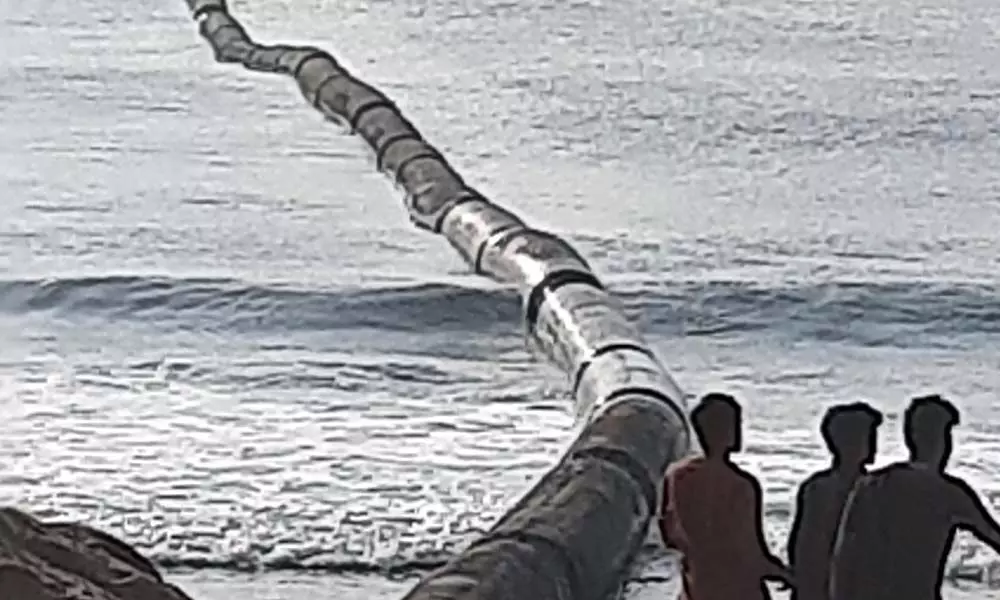Vizag Port launches beach nourishment project
Dredging Corporation in talks to new dredger with a capacity of 12,000 cubic metre
image for illustrative purpose

Visakhapatnam: THE Dredging Corporation of India Limited (DCIL) is in talks with Cochin Shipyard Limited for acquiring a new dredger with a hopper capacity of 12,000 cubic metres.
"As part of our endeavour to augment our fleet capacity, we are exploring various options to make it globally competitive," Visakhapatnam Port Trust (VPT) Chairman K Rama Mohana Rao, who is also the Chairman of DCIL, said on Wednesday after launching the annual beach nourishment project here. The construction of new dredger once finalised, is expected to take two-and-a-half to three years at an estimated cost of between Rs 600 crore and Rs 700 crore.
DCIL, which was identified for strategic sale by the Cabinet Committee on Political Affairs, was later taken over by a consortium of four major ports. The consortium comprises VPT, Paradeep Port, Jawaharlal Nehru Port Trust (JNPT) and Deendayal (Kandla) Port. On payment of Rs 1,050 crore in 2019, they bought a government stake of 73.47 per cent.
Rao said they were also planning for jumboisation of some old dredgers to increase their capacity. He said while pursuing the efforts for construction of a new dredger, they were also planning to increase the hopper capacity of a few dredgers with a hopper capacity of 5,500 cubic metres to 7,500 cubic metres. Jumboisation will cost Rs 200 to Rs 400 crore crore for each dredger.
DCIL has plans to achieve a hopper capacity of 160 million cubic metres in the next 10 years from the present capacity of 60 million cubic metres. The present demand for maintenance dredging is 105 million cubic metres.
The VPT Chairman said the port was firm on bringing pollution to bare minimum and mentioned how they were trying to get clearance from the AP Pollution Control Board to spray some chemicals without causing any harm to form a small layer on coal cargo to prevent spread of dust. He said they had spent Rs.8 crore on a dust separation system.
Beach nourishment
According to Rao, the beach nourishment project had been awarded to DCIL for three years as part of its corporate social responsibility at the rate of Rs 15 crore per year.
Ever since the construction of Outer Harbour, VPT has been nourishing the beach to arrest severe erosion. Change in beach morphology and certain constructions have led to erosion of the beach sand. The caving in of side wall near the fishing harbor, INS Kursura Submarine Museum, the shrinking of the beachfront area at RK Beach and Rushikonda a few years ago led to public outcry following which the government set up a high power committee led by senior IAS officer MT Krishna Babu.
On the basis of expert suggestion, structural intervention in the sea was shelved. Instead, VPT decided to increase the nourishment. Scientists from the National Institute of Oceanography say frequent formation of systems in the Bay of Bengal is also responsible for severe erosion.
When contacted, DCIL Managing Director Rajesh Tripathi told Bizz Buzz that they had adopted a short and long-term plan to make the company highly competitive. He said the beach nourishment project had always remained a highly challenging task for them and exuded confidence that it would be completed within a month.
Sand Trap dredging is carried out every year after monsoon during November-March when the turbulence in the sea is less. During south-west monsoon, due to lateral drift phenomenon, the sand gets deposited in the Sand Trap area was formed in between the Entrance Channel and Dolphin's Nose as part of management of littoral drift sediments. The deposited sand is reused by dredging and pumping at the Submarine Kursura area on the beach road but also to protect the beach and beautify it further to attract tourists.
DCIL has been mandated to collect 2.10 lakh cubic metres and complete the nourishment project this year within a year.

